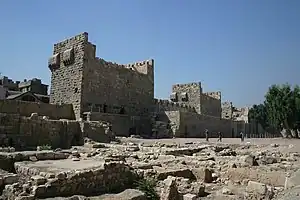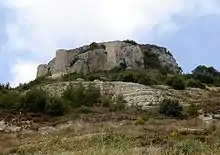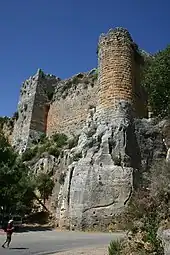This is a list of castles in Syria.
Key
| Key | |
| Name | Name of the surviving building, either how it is popularly known in English, its medieval name or its Arabic name |
| Type | Usually the type of castle represented by the predominant surviving fortified remains |
| Date | Usually the dates of the principal building works relating to the surviving remains |
| Condition | An indication as to what remains of the original castle structure |
| Image | Building or site as it currently exists |
| Coordinates | Location of the castle |
| Governorate | Governorate in which the castle is located |
| Notes | Brief description or information of note |
List of castles
| Located under Israeli occupation. |
See also
Wikimedia Commons has media related to Castles in Syria.
References
- ↑ Sourdel 2010
- ↑ Ancient City of Damascus, UNESCO World Heritage Centre, retrieved 16 March 2011
- ↑ Ancient City of Bosra, UNESCO World Heritage Centre, retrieved 23 August 2011
- ↑ Burns 2009
- ↑ Shaw & Jameson 1999, p. 167
- ↑ "Discovery of a 4,000-year-old military network in northern Syria". cnrs.fr. 19 December 2017.
- ↑ King 2002, p. 42
- 1 2 Crac des Chevaliers and Qal'at Salah El-Din, UNESCO World Heritage Centre, retrieved 24 August 2011
- ↑ Heidemann 2006, p. 122
- ↑ Bounni 1977
- ↑ Barker, Graeme (1999). Companion Encyclopedia of Archeology Volume 1-2. London: Routledge. p. 1086. Retrieved 13 December 2021.
- ↑ Willey 2005, p. 234
Sources
- Bounni, Adnan (1977), "Campaign and exhibition from the Euphrates in Syria", The Annual of the American Schools of Oriental Research, 44: 1–7, JSTOR 3768538
- Burns, R. (2009), The monuments of Syria. A guide, London: I.B. Tauris, pp. 160–161, ISBN 9781845119478
- Heidemann, Stefan (2006), "The Citadel of al-Raqqa and Fortifications in the Middle Euphrates Area", in Kennedy, Hugh (ed.), Muslim Military Architecture in Greater Syria: From the Coming of Islam to the Ottoman Period, History of Warfare, vol. 35, Leiden: Brill, pp. 122–150, ISBN 9004147136
- King, G.R.D. (2002), "Archaeological Fieldwork at the Citadel of Homs, Syria: 1995–1999", Levant, 34: 39–58, doi:10.1179/007589102790217336
- Shaw, Ian; Jameson, Robert (1999), A Dictionary of Archaeology, Oxford: Blackwell, ISBN 978-0631174233
- Sourdel, D. (2010), "Ķalat Nadjm", in Bearman, P.; Bianquis, Th.; Bosworth, C.E.; van Donzel, E.; Heinrichs, W.P. (eds.), Encyclopaedia of Islam, Second Edition, Leiden: Brill Online, OCLC 624382576
- Willey, Peter (2005), Eagle's Nest: Ismaili Castles in Iran and Syria, Institute of Ismaili Studies, I.B.Tauris, ISBN 9781850434641
This article is issued from Wikipedia. The text is licensed under Creative Commons - Attribution - Sharealike. Additional terms may apply for the media files.



























